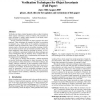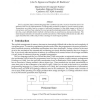624 search results - page 69 / 125 » The Complexity of Type Analysis of Object Oriented Programs |
POPL
2010
ACM
14 years 5 months ago
2010
ACM
This paper introduces a new approach to type theory called pure subtype systems. Pure subtype systems differ from traditional approaches to type theory (such as pure type systems)...
ECOOP
2008
Springer
13 years 9 months ago
2008
Springer
Verification of object-oriented programs relies on object invariants which express consistency criteria of objects. The semantics of object invariants is subtle, mainly because of...
BMCBI
2007
13 years 7 months ago
2007
Background: DNA melting curve analysis using double-stranded DNA-specific dyes such as SYTO9 produce complex and reproducible melting profiles, resulting in the detection of multi...
PLDI
2012
ACM
11 years 10 months ago
2012
ACM
Concurrent, object-oriented programs often use thread-safe library classes. Existing techniques for testing a thread-safe class either rely on tests using the class, on formal spe...
POS
1998
Springer
13 years 12 months ago
1998
Springer
Java is a popular, object oriented language that is runtime type safe. As such, it has been seen as an attractive basis for the implementation of orthogonally persistent systems b...


